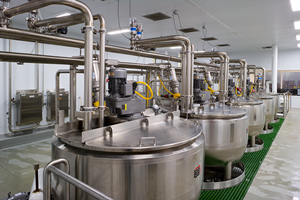Sign up to be notified of our new blog posts.
How to Improve Food Safety in Your Plant Operations
Posted on March 29, 2018

Summary
- Sanitary features in kettle design support clean-in-place (CIP) systems.
- Sloped and rounded exterior components reduce water collection risks.
- Used kettles should be evaluated carefully to avoid contamination.
Why Is Sanitary Design Critical in Food Processing Kettles?
Assuring that your product will always be sanitary and free of contaminants is a critical food processing goal. So, when you are planning the design and configuration of your next kettle purchase, it is important to keep food safety in mind.What Sanitary Features Improve Clean-In-Place (CIP) Efficiency?
Important design features and fabrication techniques can be integrated into new kettles. These sanitary features optimize a clean-in-place (CIP) system. Higher-grade surface finishes can be used on all food contact surfaces to increase CIP cleaning efficiency. By welding, grinding, then polishing weld joints and seams—smooth, sanitary and easily cleanable surfaces are created.How Can You Prevent Water Collection on the Kettle Exterior?
Another food safety issue is water collection on the outside of the kettle. Several design features can eliminate this risk:
- Channel Risers
To move water away from the top of the vessel, channel risers can be used to slope the channel bridge on the kettle’s top motor mount.
- Kettle Covers
Sloped kettle covers will also allow water and other fluids to run off the top of the cover.
- Kettle Legs
Using round stock for kettle legs, instead of flat bars, can also help prevent water collection.
What Other Design Enhancements Help Prevent Contamination?
Pipeline metal detection enhancements, such as scraper blades saturated with stainless steel powder, can also be used to prevent contamination of food products during processing.What Should You Consider Before Buying a Used Kettle?
If you are considering purchasing a used kettle, it is critical to determine what ingredients were processed in the kettle. For example:
- A kettle that was previously used to mix or process hazardous, reactive chemicals or pharmaceutical products may pose too high a risk for use in food processing, due to possible cross-contamination from trace chemical ingredients lodged in bushing spaces and other areas.
- You should also check food safety features, such as sanitary ball valves, easily drainable cross-members and support legs, and CIP support.
- For more advice about buying used kettles, review this informative article.
What Kettle Configurations Contribute to Food Safety?
Food safety is obviously a primary goal for manufacturers. To learn more about kettle design and configuration to optimize safety, quality and production, download our optimizing and expanding guide.
What Kettle Configurations Contribute to Food Safety?
Food safety is obviously a primary goal for manufacturers. To learn more about kettle design and configuration to optimize safety, quality and production, download our optimizing and expanding guide.
Key Takeaways
- Sanitary features like polished welds and smooth finishes support CIP systems.
- Sloped covers, risers, and round legs reduce water collection that can cause contamination.
- Metal-detectable components improve safety during mixing.
- Always verify the history of used kettles before purchasing.
Frequently Asked Questions (FAQ)
Q: What are sanitary features in food kettles?
A: These include high-grade finishes, polished welds, and smooth interior surfaces that help prevent bacteria growth and allow for efficient cleaning.
Q: Why is exterior water collection a food safety risk?
A: Standing water on kettle surfaces can attract and harbor bacteria. Sloped and rounded designs help water run off quickly.
Q: Can I use a used kettle for food processing?
A: Before purchasing a used kettle, it’s critical to understand how it was used previously. Cross-contamination from pharmaceutical or chemical residues may pose a serious risk if the used kettle is being considered for processing food products.
Q: What kind of CIP enhancements should I look for?
A: Features like sanitary ball valves, drainable supports, and metal-detectable scraper blades are valuable additions to food-safe kettle designs.
Last Updated: 10/13/2025
Comments
Add Your Own Comment